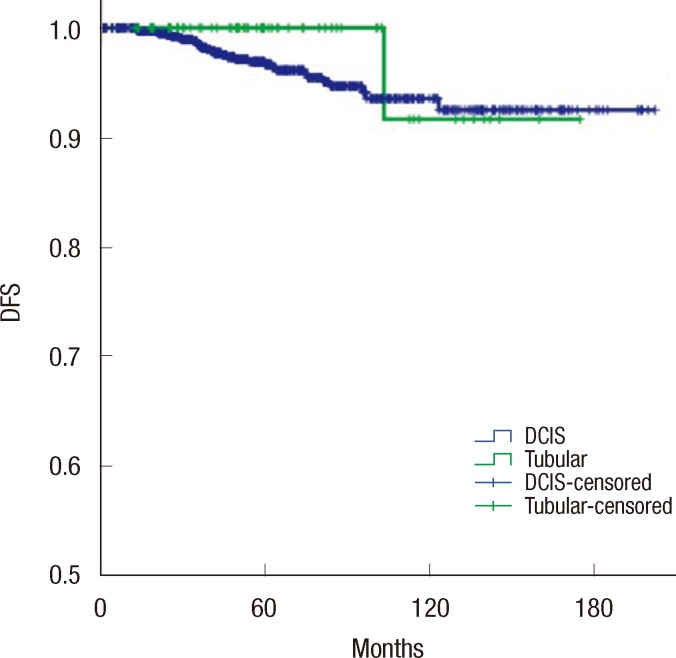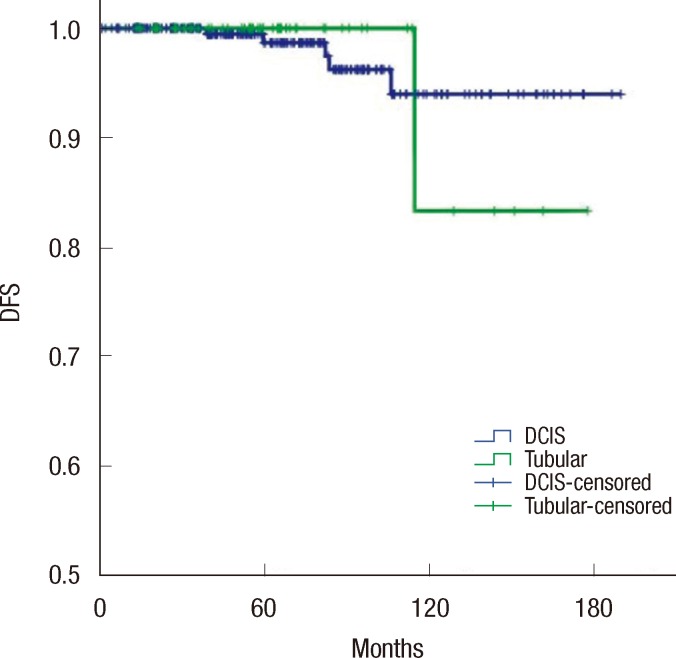J Breast Cancer.
2013 Dec;16(4):404-409. 10.4048/jbc.2013.16.4.404.
Tubular Carcinoma of the Breast: Clinicopathologic Features and Survival Outcome Compared with Ductal Carcinoma In Situ
- Affiliations
-
- 1Division of Breast & Endocrine Surgery, Department of Surgery, Samsung Medical Center, Sungkyunkwan University School of Medicine, Seoul, Korea. seokjin.nam@samsung.com
- KMID: 1976378
- DOI: http://doi.org/10.4048/jbc.2013.16.4.404
Abstract
- PURPOSE
Tubular carcinoma (TC) of the breast is an uncommon histological subtype of invasive breast cancer with an excellent prognosis compared with standard invasive ductal carcinoma. Recent studies suggested a possible precursor role for low grade ductal carcinoma in situ (DCIS) in the development of TC. The goal of this analysis was to understand the clinicopathologic features and outcomes of TC by comparing TC with DCIS.
METHODS
A retrospective review identified 70 patients with TC and 1,106 patients with DCIS between 1995 and 2011. Student t-test and Fisher exact test were used to compare the clinicopathologic characteristics of TC patients with those of DCIS patients. The Kaplan-Meier method and Cox regression analysis were used to determine disease-free survival (DFS) rates.
RESULTS
Compared to DCIS, TC exhibited favorable clinicopathologic characteristics such as a lower nuclear grade (92.3%), higher expression of hormonal receptors (estrogen receptor-positive, 92.9%; progesterone receptor-positive, 87.0%), and less frequent overexpression of human epidermal growth receptor 2 (12.9%). DFS did not differ significantly between the TC and DCIS groups (5-year DFS, 100% vs. 96.7%; 10-year DFS, 92.3% vs. 93.3%; p=0.324), and cancer-specific deaths were not noted in either group. However, axillary lymph node involvement was observed in six (8.6%) of the 70 patients with TC. Three of these patients had small tumors (< or =1 cm).
CONCLUSION
In our study cohort, TC was associated with an excellent prognosis and a low rate of lymph node metastasis. However, lymph nodes metastases were found even in patients with small tumors (< or =1 cm). Axillary staging must be considered for all patients with TC of the breast.
MeSH Terms
Figure
Reference
-
1. Sullivan T, Raad RA, Goldberg S, Assaad SI, Gadd M, Smith BL, et al. Tubular carcinoma of the breast: a retrospective analysis and review of the literature. Breast Cancer Res Treat. 2005; 93:199–205. PMID: 16142444.
Article2. Cabral AH, Recine M, Paramo JC, McPhee MM, Poppiti R, Mesko TW. Tubular carcinoma of the breast: an institutional experience and review of the literature. Breast J. 2003; 9:298–301. PMID: 12846864.
Article3. Rakha EA, Lee AH, Evans AJ, Menon S, Assad NY, Hodi Z, et al. Tubular carcinoma of the breast: further evidence to support its excellent prognosis. J Clin Oncol. 2010; 28:99–104. PMID: 19917872.
Article4. Cooper HS, Patchefsky AS, Krall RA. Tubular carcinoma of the breast. Cancer. 1978; 42:2334–2342. PMID: 214219.
Article5. McDivitt RW, Boyce W, Gersell D. Tubular carcinoma of the breast: clinical and pathological observations concerning 135 cases. Am J Surg Pathol. 1982; 6:401–411. PMID: 6289683.6. Leibman AJ, Lewis M, Kruse B. Tubular carcinoma of the breast: mammographic appearance. AJR Am J Roentgenol. 1993; 160:263–265. PMID: 8424330.
Article7. Livi L, Paiar F, Meldolesi E, Talamonti C, Simontacchi G, Detti B, et al. Tubular carcinoma of the breast: outcome and loco-regional recurrence in 307 patients. Eur J Surg Oncol. 2005; 31:9–12. PMID: 15642419.
Article8. Fedko MG, Scow JS, Shah SS, Reynolds C, Degnim AC, Jakub JW, et al. Pure tubular carcinoma and axillary nodal metastases. Ann Surg Oncol. 2010; 17(Suppl 3):338–342. PMID: 20853056.
Article9. Diab SG, Clark GM, Osborne CK, Libby A, Allred DC, Elledge RM. Tumor characteristics and clinical outcome of tubular and mucinous breast carcinomas. J Clin Oncol. 1999; 17:1442–1448. PMID: 10334529.
Article10. Javid SH, Smith BL, Mayer E, Bellon J, Murphy CD, Lipsitz S, et al. Tubular carcinoma of the breast: results of a large contemporary series. Am J Surg. 2009; 197:674–677. PMID: 18789411.
Article11. Kader HA, Jackson J, Mates D, Andersen S, Hayes M, Olivotto IA. Tubular carcinoma of the breast: a population-based study of nodal metastases at presentation and of patterns of relapse. Breast J. 2001; 7:8–13. PMID: 11348409.
Article12. Fernandez-Aguilar S, Noël JC. Expression of cathepsin D and galectin 3 in tubular carcinomas of the breast. APMIS. 2008; 116:33–40. PMID: 18254778.
Article13. Abdel-Fatah TM, Powe DG, Hodi Z, Lee AH, Reis-Filho JS, Ellis IO. High frequency of coexistence of columnar cell lesions, lobular neoplasia, and low grade ductal carcinoma in situ with invasive tubular carcinoma and invasive lobular carcinoma. Am J Surg Pathol. 2007; 31:417–426. PMID: 17325484.
Article14. Aulmann S, Elsawaf Z, Penzel R, Schirmacher P, Sinn HP. Invasive tubular carcinoma of the breast frequently is clonally related to flat epithelial atypia and low-grade ductal carcinoma in situ. Am J Surg Pathol. 2009; 33:1646–1653. PMID: 19675453.
Article15. Kunju LP, Ding Y, Kleer CG. Tubular carcinoma and grade 1 (well-differentiated) invasive ductal carcinoma: comparison of flat epithelial atypia and other intra-epithelial lesions. Pathol Int. 2008; 58:620–625. PMID: 18801081.
Article16. Man S, Ellis IO, Sibbering M, Blamey RW, Brook JD. High levels of allele loss at the FHIT and ATM genes in non-comedo ductal carcinoma in situ and grade I tubular invasive breast cancers. Cancer Res. 1996; 56:5484–5489. PMID: 8968105.17. Winchester DJ, Sahin AA, Tucker SL, Singletary SE. Tubular carcinoma of the breast: predicting axillary nodal metastases and recurrence. Ann Surg. 1996; 223:342–347. PMID: 8604915.18. Stalsberg H, Hartmann WH. The delimitation of tubular carcinoma of the breast. Hum Pathol. 2000; 31:601–607. PMID: 10836300.19. Hansen CJ, Kenny L, Lakhani SR, Ung O, Keller J, Tripcony L, et al. Tubular breast carcinoma: an argument against treatment de-escalation. J Med Imaging Radiat Oncol. 2012; 56:116–122. PMID: 22339755.
Article20. McBoyle MF, Razek HA, Carter JL, Helmer SD. Tubular carcinoma of the breast: an institutional review. Am Surg. 1997; 63:639–644. PMID: 9202540.21. Shin HJ, Kim HH, Kim SM, Kim DB, Lee YR, Kim MJ, et al. Pure and mixed tubular carcinoma of the breast: mammographic and sonographic differential features. Korean J Radiol. 2007; 8:103–110. PMID: 17420627.
Article22. Abdel-Fatah TM, Powe DG, Hodi Z, Reis-Filho JS, Lee AH, Ellis IO. Morphologic and molecular evolutionary pathways of low nuclear grade invasive breast cancers and their putative precursor lesions: further evidence to support the concept of low nuclear grade breast neoplasia family. Am J Surg Pathol. 2008; 32:513–523. PMID: 18223478.
Article23. Fernandez-Aguilar S, Jondet M, Simonart T, Nöel JC. Microvessel and lymphatic density in tubular carcinoma of the breast: comparative study with invasive low-grade ductal carcinoma. Breast. 2006; 15:782–785. PMID: 16931017.
Article24. Fernández-Aguilar S, Simon P, Buxant F, Simonart T, Noël JC. Tubular carcinoma of the breast and associated intra-epithelial lesions: a comparative study with invasive low-grade ductal carcinomas. Virchows Arch. 2005; 447:683–687. PMID: 16091953.
Article25. Fasano M, Vamvakas E, Delgado Y, Inghirami G, Mitnick J, Roses D, et al. Tubular carcinoma of the breast: immunohistochemical and DNA flow cytometric profile. Breast J. 1999; 5:252–255. PMID: 11348296.
Article26. Dejode M, Sagan C, Campion L, Houvenaeghel G, Giard S, Rodier JF, et al. Pure tubular carcinoma of the breast and sentinel lymph node biopsy: a retrospective multi-institutional study of 234 cases. Eur J Surg Oncol. 2013; 39:248–254. PMID: 23273874.
Article27. Clinical practice guidelines in oncology - v.3.2013. National Comprehensive Cancer Network. Accessed August 12th, 2013. http://www.nccn.org/professionals/physician_gls/pdf/breast.pdf.28. Lucci A, McCall LM, Beitsch PD, Whitworth PW, Reintgen DS, Blumencranz PW, et al. Surgical complications associated with sentinel lymph node dissection (SLND) plus axillary lymph node dissection compared with SLND alone in the American College of Surgeons Oncology Group Trial Z0011. J Clin Oncol. 2007; 25:3657–3663. PMID: 17485711.
Article
- Full Text Links
- Actions
-
Cited
- CITED
-
- Close
- Share
- Similar articles
-
- Invasive Lobular Carcinoma of the Breast Associated with Mixed Lobular and Ductal Carcinoma In Situ: A Case Report
- Apocrine Ductal Carcinoma In Situ of the Breast Presented Mass with Morphological Change on Follow-Up Ultrasound: A Report of Case
- An Unusual Presentation of Extensive Ductal Carcinoma in Situ Accompanying Invasive Ductal Carcinoma on MRI: A Case Report
- Clinicopathologic Characteristics of Apocrine Breast Carcinoma
- Clinicopathological analysis of ductal carcinoma in situ(DCIS) and ductal carcinoma in situ with microinvasion



